Weed killers. List of effective weed killers.
Weed – wild plant with exceptional survival abilities. Their seeds are perfectly preserved, their productivity is very high, they spread the most different ways and tolerate heat and drought well. In areas where garden plants are grown, weeds are extremely undesirable, since, due to their characteristics, they easily crowd out cultivated plants.
A variety of plants fall under the definition of weed. So, for a lawn, dandelion and bindweed will also be weeds, while for an artificial, and even more so a natural lawn, this is an excellent option. On garden beds in principle, the existence of any other plants other than cultivated ones is not allowed, but in the garden there are more opportunities.
All weeds are divided into 2 groups: perennial and annual. For obvious reasons, they need to be dealt with in different ways.
Perennial - most of them exist in one place for up to 4 years. After the seeds ripen, the above-ground part of the weed dies off, but the root system remains intact. next year gives new growth.
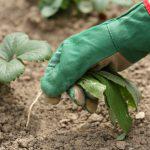
Plants reproduce both by seeds and vegetatively, which makes these “guests” in the garden and flower bed especially unpleasant. The most famous in this group include:
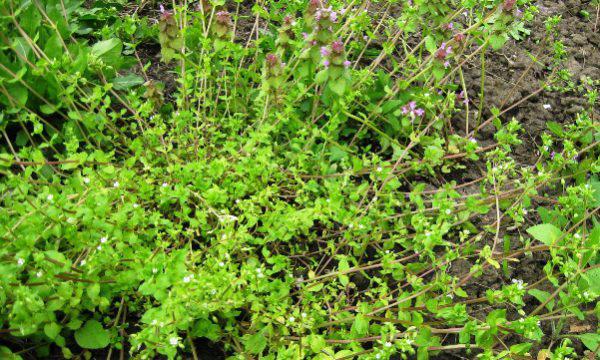
Annuals - their lifespan is only 1 year, which makes them easier to control. Most often in the garden you encounter the following plants: Annual weeds are much easier to control. The main thing in such cases is to prevent the weed from producing seeds and to prevent further growth
. Destroying perennial weeds will require much more effort.
But how it should be used, and how it is applied, is described in great detail in the article at the link.
How to use the comfort sprayer Umnitsa oel 16 can be seen in this
It will also be interesting to learn about how mulberries are grown in the Moscow region:
Fighting methods
Due to the huge variety of wild grasses and flowers, there is no single method for controlling them. But if you know the characteristics of the growth and spread of weeds, it is easier to get rid of them.
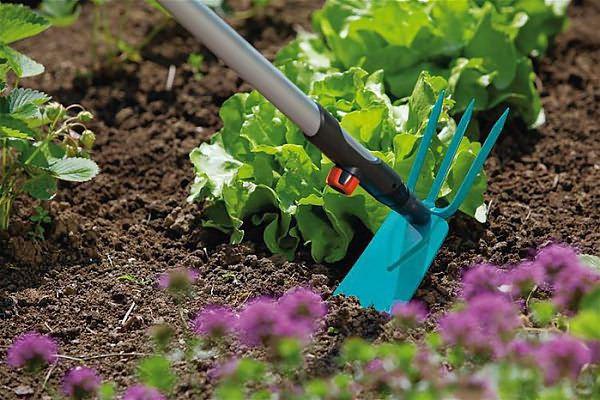
All control methods are divided into 2 main groups:
The most effective procedures of this kind include herbicide treatment. However, weeds can be destroyed using less dangerous folk remedies.
No matter how effective modern chemistry is, weeding and removing plants by hand have been and remain the most popular and used methods of control. Every summer resident, gardener, and even owner comes across this folk remedy. indoor plants, if the latter live on an open balcony.
The main tool for destroying weeds remains the hoe in all its modifications. The usual one also comes into play kitchen knife, a narrow scoop with sharp edges, a flat cutter, a rake and slightly more advanced devices, like cultivators.
Mechanical treatment of the area involves the following actions.
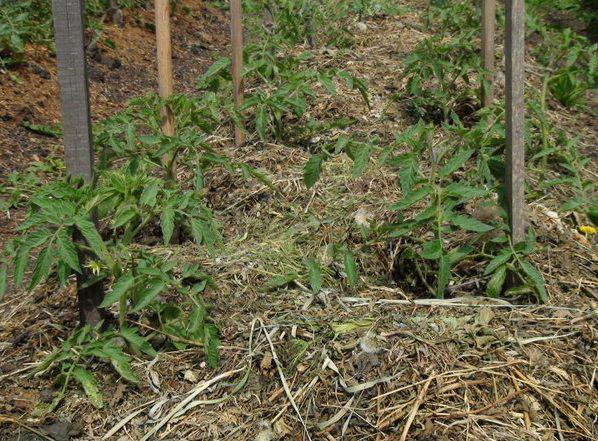
Regardless of what folk remedies a summer resident uses to fight weeds, weeding has been and remains a constant procedure in the garden. You need to weed the beds at least once every 2-3 weeks from spring to late autumn.
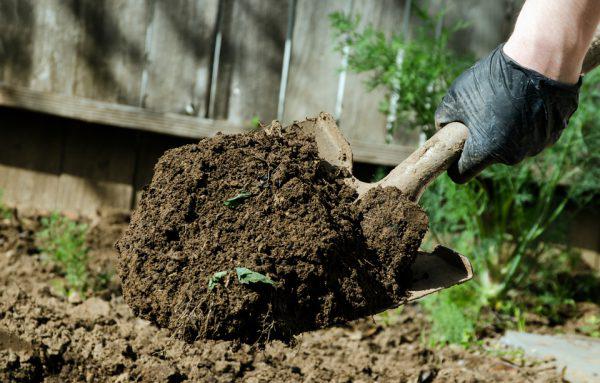
Chemical methods
The use of herbicides is not always justified, not always useful, and in some cases it is impossible. Folk remedies may be less effective, but they are definitely less dangerous.
Spraying of plants and treatment of soil is carried out in dry, windless weather in order to prevent solutions from getting on the leaves and stems of cultivated plants. In addition, dampness, especially rain, significantly weakens the effect of the substance, as it reduces its concentration.
- Alcohol– this method has American roots and is considered very effective. Medical alcohol diluted with water in a ratio of 1:10 and the resulting solution is used to treat the soil between seedlings. 11 liters is enough to process about 2–2.5 acres. According to summer residents, this method gets rid of weeds this year.
- Soda– treat the soil around the plants with a strong soda solution. The liquid is highly alkaline and successfully destroys biological material. The effect of soda is enhanced by the addition of liquid or grated laundry soap.
- Salt– the substance is sprinkled on the area around the plant at some distance from it. Soaked in upper layer soil, salt not only destroys thistle or wheatgrass that has already appeared, but also does not allow new shoots to appear.
- Vinegar– the product is most effective until the weeds have entered the seed formation stage. The stems and leaves of the weed are treated with the liquid, carefully so that the vinegar does not get on the leaves of the cultivated plant. Use a pump or a spray can for this purpose. Several different recipes are used:
The video shows chemical methods for removing weeds:
- 5 glasses of vinegar (6% solution) are diluted in 2 liters of water. This volume is enough to process 2 acres;
- 3 shares of vinegar (9% solution) are mixed with 1 share of lemon juice;
- Dissolve 5 tablespoons of vinegar and 2 tablespoons of salt in 1 liter of water. This mixture is used hot, from folk remedies it is considered perhaps the most effective.
Herbicidal soap– prepare it like this: 1 liter of white vinegar and 150 g of kitchen salt are mixed with 1 syringe liquid soap or with the same volume of grated laundry soap. The solution is shaken until the components are completely dissolved and the ground under the weeds is treated with it. Maximum effect achieved by using strong vinegar - 15–20%.
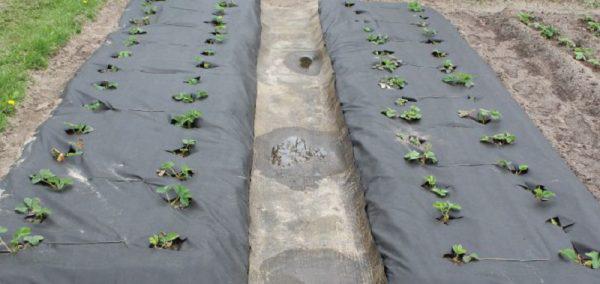
Herbicidal soap
One-time treatment allows you to destroy existing weeds and slow down the growth of new ones. However, to achieve a sustainable effect, chemical treatment must be repeated several times at intervals of a week. It is especially important to treat weeds before flowering.
Effective weed control in the garden and garden requires a combination of mechanical and chemical methods. You cannot completely get rid of weeds if you resort only to treatment with vinegar, for example, it is necessary to carry out weeding and digging.
These nasty weeds always make our lives difficult. They force us to work in the garden more than we would like. Weed control requires constant attention; if you were a little lazy, they again covered the area with a solid carpet. How to fight? Is it possible? Do you need to get rid of them? What harm do they do? Which ones are the most harmful? What means of control exist? Which ones do you absolutely need to get rid of? What if they bring benefits, but we struggle and struggle?...
There are many herbicides to control weeds and weed killers. Each is designed for specific species. Read the instructions, choose the product that is most suitable for your garden. After all, each weed has certain properties to react to one or another drug. There are even special tables that take into account the sensitivity of a particular weed to a specific product.
Herbicides for weeds, what they are, which ones to use
According to the nature of their action, herbicides are divided into preparations of continuous and selective action. Continuous action herbicides affect all types of weeds, and selective action herbicides (certain doses) are dangerous for some, but relatively safe for others.
Based on their effects, herbicides can be either contact or systemic.
Contacts infect plants by direct contact with leaves, stems or roots, causing burns, necrosis, and then death of above-ground organs or their young seedlings.
Systemic ones, getting inside the weeds through ground organs or roots, are able to move throughout the plant, exerting a toxic effect on it.
According to the timing of application, herbicides are: pre-sowing, pre-emergence, post-emergence. Almost all modern drugs Gardeners apply by spraying the leaves of weeds.
If you follow the basic rules for using drugs, then chemicals should not pollute the soil or have harmful effects. However, by introducing higher doses, or for a long time By using them, you can still pollute the soil - who knows how our health will react.
Agronomist scientists advise combining chemical weed control agents + agrotechnical methods.
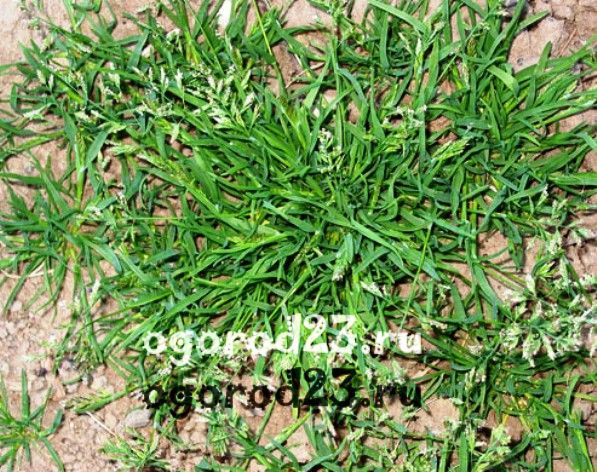 Creeping wheatgrass
Creeping wheatgrass In the fall, after harvesting, when only weeds remained, I used a systemic herbicide, such as Roundup, to combat it. It was quite effective against thistle, pigweed, wheatgrass, field bindweed (birch), acorn grass, ragweed, and others. (Read below for new warning information about Roundup.)
By the way, my experience confirms that it is best to use systemic drugs in the fall. It’s difficult for me to explain why in the fall, but I noticed that in the spring, repeated treatment of weeds is sometimes necessary, and in the fall, one treatment is enough. In addition, when planning to fight against weeds with the help of herbicides, turn over: it is best to do this during the waning moon, since at this time the sap flows from the leaves to the roots, so the drug will reach the roots faster, and you will see the result faster.
Weeds - photos and names
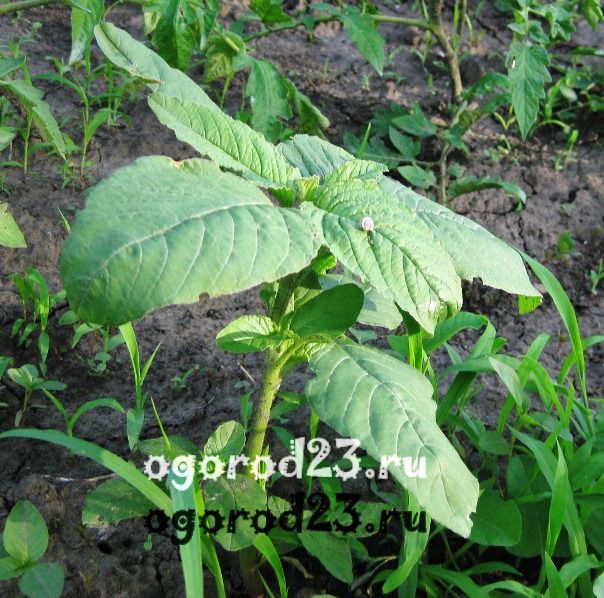 Amaranth
Amaranth I can hardly boast that I have completely defeated the weeds. Unfortunately no. But I’m glad that the number of such malicious, difficult to remove ones as pigweed and field birch has decreased, and I no longer see wheatgrass where potatoes and pumpkins are planted, but, of course, in some places it remains...
Wheatgrass is a nasty weed
I consider wheatgrass to be one of those weeds that must be gotten rid of. After all, wheatgrass roots are the main refuge of wireworms. You need to clean it especially carefully where you are going to plant potatoes. About three years ago I set myself the following task: to get rid of wheatgrass, because weeding and uprooting did not bring success. After harvesting, I walked through a potato field (3 acres) with a sprayer filled with Tornado solution. After two weeks, I noticed a partial yellowing of the weed leaves, and a week later, the entire field was white-yellow. This color indicates that the roots have begun to die. By the way, such an operation with Tornado almost completely removed wheatgrass.
By the way, experienced gardeners advise that in order to successfully combat wheatgrass, the area in the fall, after harvesting, is sown with rapeseed: sow in the fall, and bury or plow it in the spring. Canola will help you get rid of wheatgrass. In addition, this is an excellent green manure. It will play the role of green fertilizer: it will fertilize and improve your soil. Thus, the benefit will be double: get rid of weeds and improve the soil.
Birch weed, which is difficult to get rid of
The following spring there were much fewer birch trees. But she was still there.
I explain this by the fact that before digging up the potatoes, I cleared the potato plot of weeds to make digging easier and more convenient. Wheatgrass is almost impossible to pull out of the ground, especially from dry soil - I didn’t touch it. But I removed the birch branches. Apparently, before spraying Tornado, many of the birch tree roots were too deep; Tornado did not reach them.
Below I will give practical advice experienced gardeners, how to get rid of birch (convolvulus).
This weed prefers heavy clay soils with little structure acidic soils, therefore, in the fall it is necessary to add any deoxidizing material, for example, fluff lime (faceted glass per 1 m2). But remember that the same area may have different acidity in different places. If you don’t have litmus paper on hand, check it like this: pour boiling water (one glass is enough) into a handful of fresh currant or cherry leaves, let sit for a while, strain, add 2 tablespoons of soil from the area being tested, stir. When the earth settles, the infusion will change its color. If it takes on a reddish tint, then you took a sample where the soil is acidic. And if it is bluish or greenish, then the soil reaction is alkaline or neutral.
And to make it looser, in the fall, add a couple of buckets of compost or manure, which must be rotted, to an area overgrown with birch weed (convolvulus). Try to distribute these quantities over an area of 1 sq. m. m. Dig up the soil so that the compost or manure is buried 10-12 cm, no more. Such fine incorporation will stimulate the development of beneficial soil microorganisms, earthworms, the soil will become looser, more structured, and better permeable to air and water, that is, the kind that bindweed does not like. And in the spring, when the first loach shoots begin to appear, immediately treat them with herbicides: Roundup, Glyphosate, Hurricane Forte.
There is another way to combat such a malicious weed as birch (field bindweed). You can get rid of it even in one year. But only in a limited area. To do this, do not plant anything there until the end of May. Let the bindweed sprout and develop well. And then treat this area with Roundup. In three weeks, the birch shoots will turn yellow, which means that the roots have died. Clear the area of dead weeds: you can plant whatever you want there.
Pigweed - photo
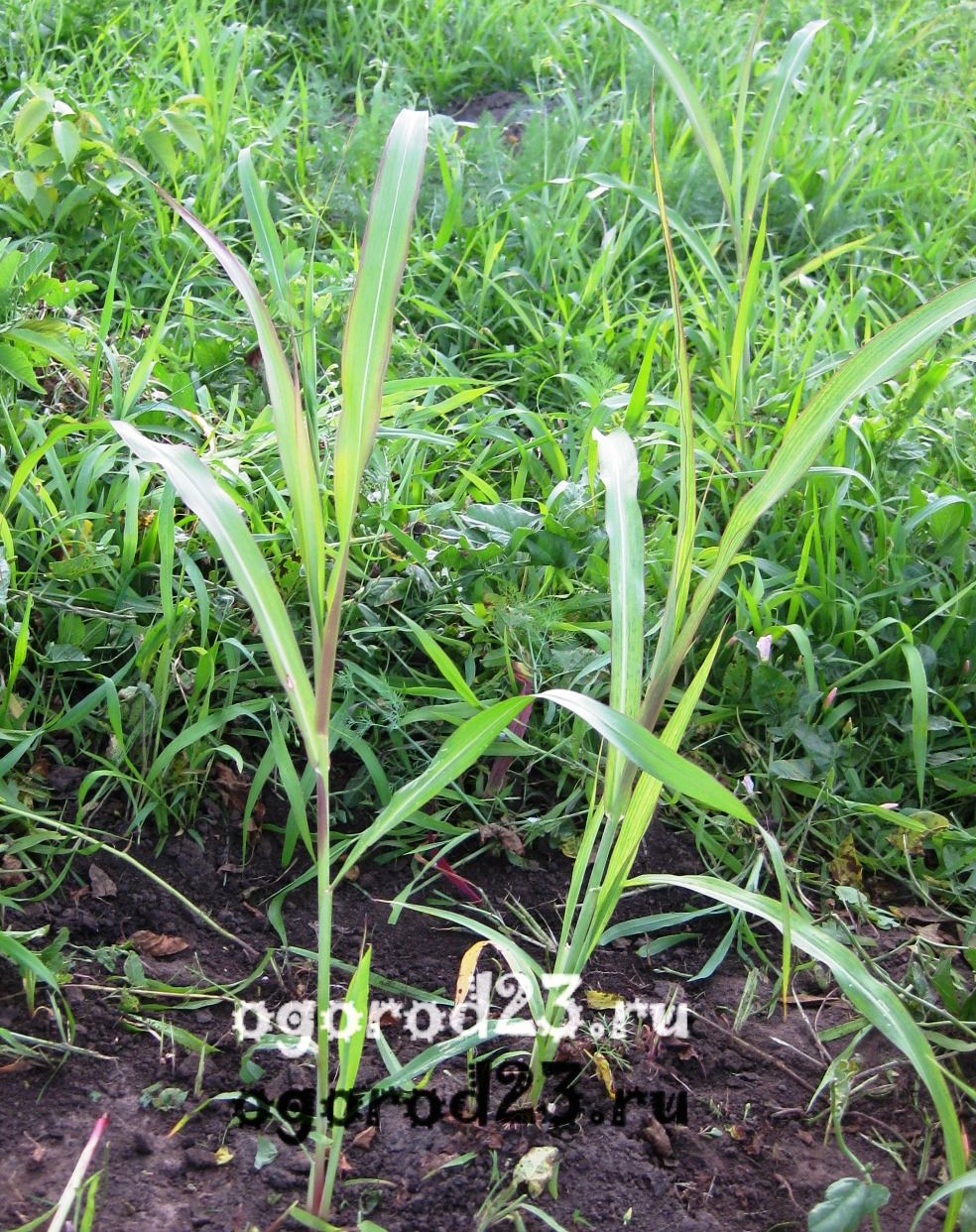 Pigweed - spreads quickly across the field, thanks to powerful lateral roots
Pigweed - spreads quickly across the field, thanks to powerful lateral roots 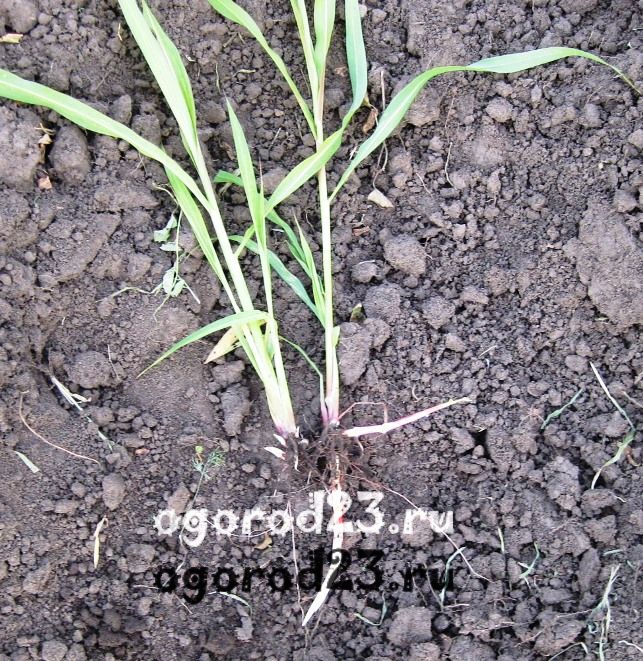 Pigweed with root system
Pigweed with root system  The pigweed has already sprouted side shoots - that’s how it reproduces
The pigweed has already sprouted side shoots - that’s how it reproduces Pigworm is also very difficult to destroy. It is propagated by pieces of rhizomes, which are formed when weeding with a hoe or when digging or plowing. Drought does not affect it, since the roots can go more than 1.5 m deep into the ground. That is, it is almost impossible to destroy it mechanically. For example, I left part of my plot unplanted, where pigweed was especially rampant, and treated it with Tornado. It helped where the weed was treated.
But, nevertheless, I was not able to remove pigweed everywhere the first time. The task is complicated by the fact that it crawls out of the ground after the sprouting of garden plants. It is dangerous to treat with herbicides - you can inadvertently touch garden seedlings. All that remains is to wait for the harvest... And all summer I walk around the site after the rain, pulling it out with a pig, or rather, trying to pull it out, since the main part of the root still remains underground. I pull it out where it grows too close to, for example, a pumpkin or squash bush. And if I see a pigweed among garden plants, then I just cut off the spikelets that are beginning to form in order to somehow prevent its seed reproduction.
I know one gardener who was destroyed by pigweed (he has 8 acres of land) - his plot has been free of this weed for several years. For many years in a row, after autumn plowing, he walked around his field with a trident manual cultivator, pulled out the pig roots cut by the plow from the freshly plowed ground.
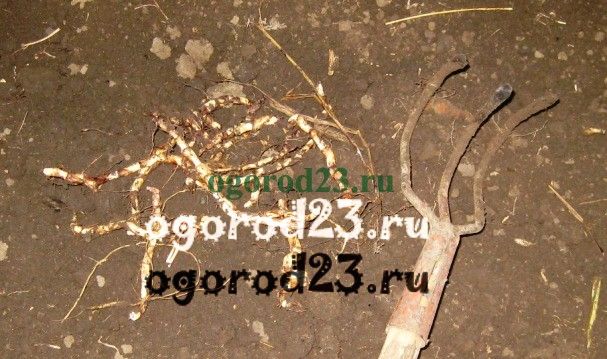 Pigroot Roots
Pigroot Roots Of course, it will not be possible to select all the roots at once - in this way you can collect only a small part of them - the main root still remains deep underground, but by doing this annually, we weaken the weeds - sooner or later we will defeat it. Everything must be selected from the ground, even small parts of the root of the pigweed. The tiniest piece, less than 1 cm long, will germinate in the spring. In the spring, we again need to walk through the plowed field - we will probably find roots that we accidentally walked around in the fall. Mechanical struggle with the weed weed should be combined with treatment with drugs.
The third year has passed since the first fall treatment of weeds chemicals. Lately I prefer to use Tornado. There are much fewer weeds where I plant potatoes, corn, sunflowers, pumpkins, and zucchini. There is almost no wheatgrass. But there are still others... After harvesting, it is still easier to fight them.
But the areas planted with strawberries, raspberries, and others perennial crops, getting rid of weeds completely or partially is a very labor-intensive, almost daily job... I keep dreaming of planting strawberries on black spunbond, which covers the entire ground, preventing grass from sprouting. But for now I’m just dreaming... Although there is positive experience in controlling weeds this way.
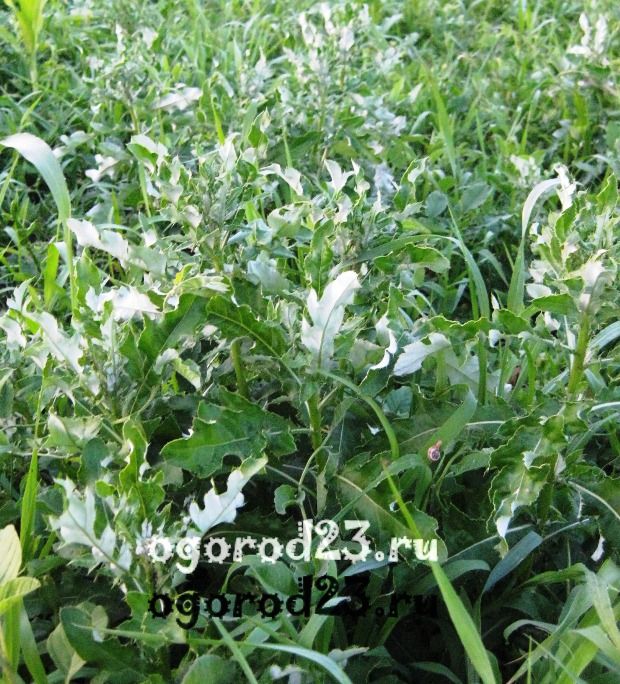 Thistle thickets
Thistle thickets 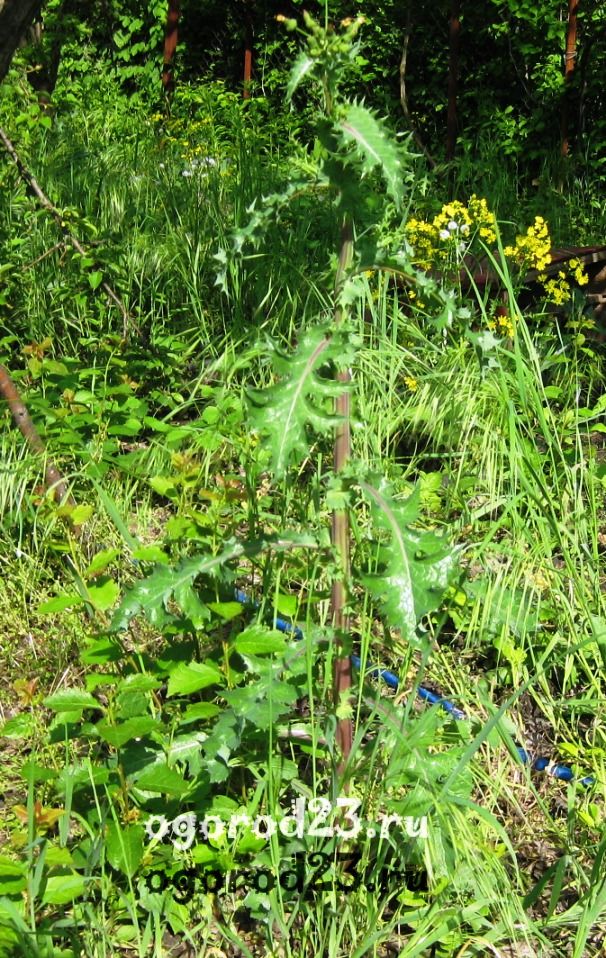 This 1.5 meter tall sow thistle is freedom!
This 1.5 meter tall sow thistle is freedom! 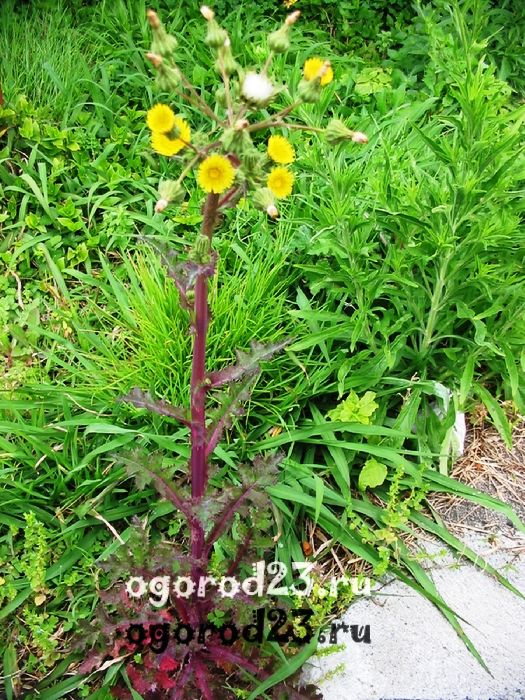 This is how thistle blooms
This is how thistle blooms 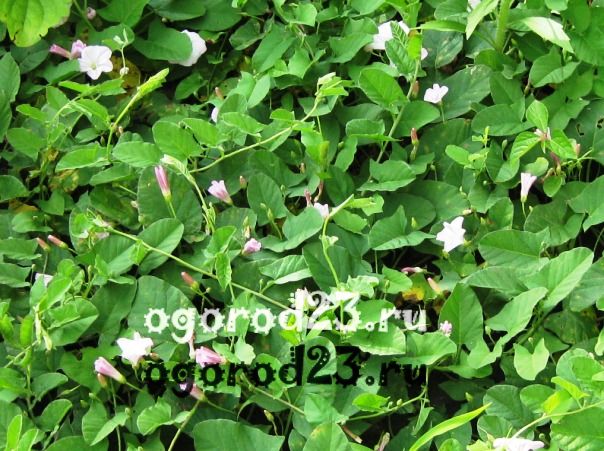 The birch tree (bindweed) has woven everything - you can’t even see the ground
The birch tree (bindweed) has woven everything - you can’t even see the ground 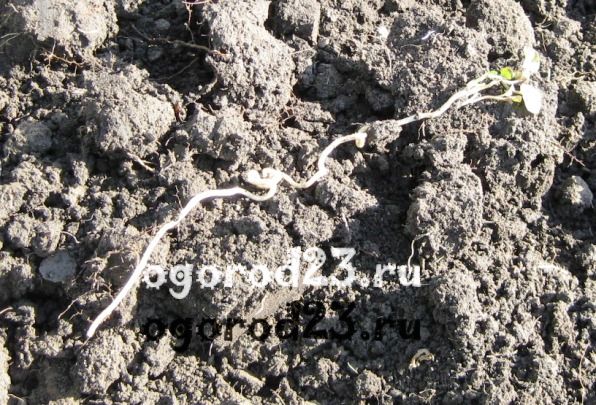 Birch tree in spring - the main part is underground
Birch tree in spring - the main part is underground I use herbicides only on large areas the lands that I have are intended for growing potatoes, corn, sunflowers, and pumpkins. Small areas that are located between fruit trees, shrubs, between areas planted with strawberries and raspberries, I try not to treat them with chemicals.
Purslane, photo and how to get rid of it
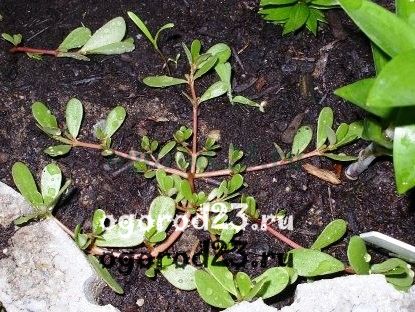 Purslane is still very small
Purslane is still very small This year there was a lot of purslane. It has fleshy, dense leaves, reddish thick stems, and grows as if in a rosette. Sometimes one weed can cover a significant area of land with its shoots. It appeared from the ground after the potatoes had sprouted. It was impossible to spray with poisons. I had to spend the whole summer working with a hoe. This weed is also unpleasant because after weeding it must be removed; if left, it can take root again if left on damp soil, for example after rain. A hoe for purslane is not always dangerous - its root neck is underground, if you cut above it, new shoots will soon appear. It is best to pull it out of the soil by the roots or cut off the root with a hoe at a depth of at least 2 centimeters.
Woodlice weed - photo, how to fight
Woodlice or chickweed is a weed that spreads especially quickly where carrots grow.
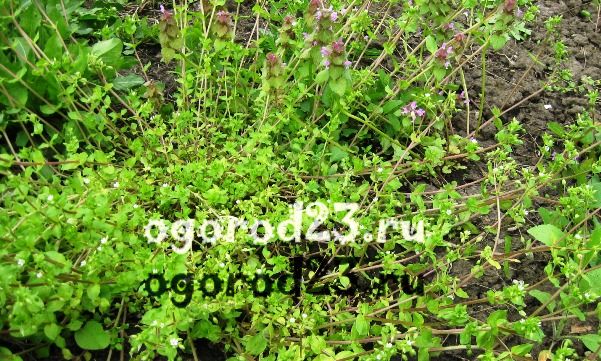 Woodlice can occupy a huge area
Woodlice can occupy a huge area This uninvited “neighbor” thickens the plantings and interferes with the normal development of plants. How to deal with a weed like woodlice?
The fight will be successful with the help of kerosene. Fill the sprayer with a small amount of kerosene - 100 grams will be enough. Spray carrot crops, covering the row spaces where woodlice grows. This should only be done when the woodlice shoots are in the three-leaf phase, only in dry, sunny weather. After two or three days, the woodlice will wither and then dry up. Don't worry, the carrots will continue to grow. From my own experience I can say that after such treatment it grows even better.
Forest chist is a weed
There is another weed in my garden that is very difficult to get rid of. This is a forest clear.
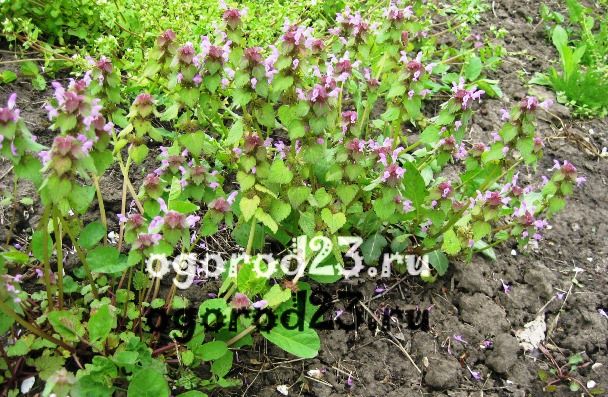 Chistets forest (dead nettle)
Chistets forest (dead nettle) It is also called dead nettle, toad grass, and snake grass. As children, we called it dog nettle or “doggy” - the flowers are shaped like an open dog’s mouth. This is a perennial. No amount of digging or weeding helps. In Kuban it blooms in April-May. It reproduces from nodules, which are located at the ends of the roots, located deep underground. It also reproduces by seeds, but they have a thick shell, so it is difficult to germinate. The only advantage of this weed is that if you weed it out in the spring, it will not appear this year; it will sprout only next spring.
Watch a video that offers a very effective way get rid of weeds forever.
If grass grows from cracks along a concrete path, or from any other hard surface, prepare the following mixture: 2 cups vinegar (9%), 1/4 cup salt, a few drops of liquid dishwashing detergent. Place the mixture in a jar or bottle, screw on the lid, and shake well. If the cracks are narrow, then take the mixture with a syringe and apply it inside the crack along the entire length. And if the cracks are wide, then fill the crack with the mixture through the narrow neck of a bottle or the spout of an old kettle. A simple alternative to this method is to pour boiling salted water into the cracks. But it is advisable that water does not get in and harm the garden plants.
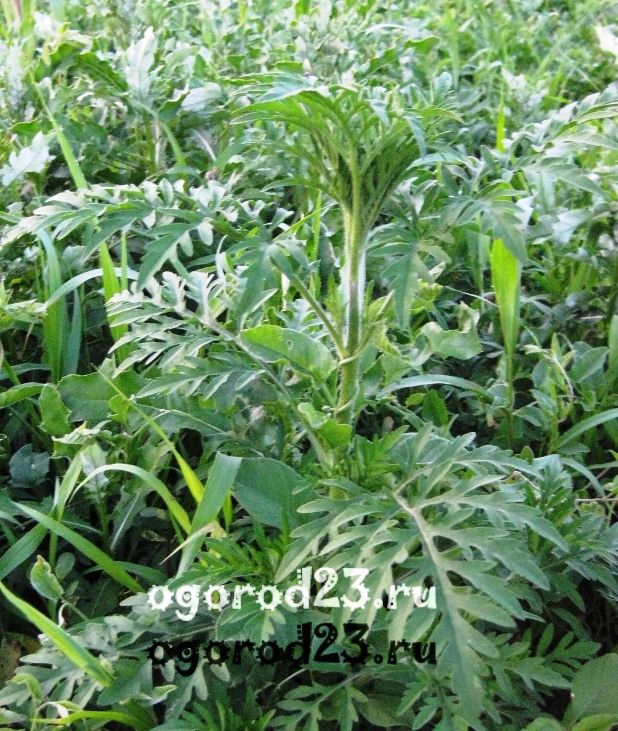 Ambrosia is very harmful to gardens and people with allergies
Ambrosia is very harmful to gardens and people with allergies 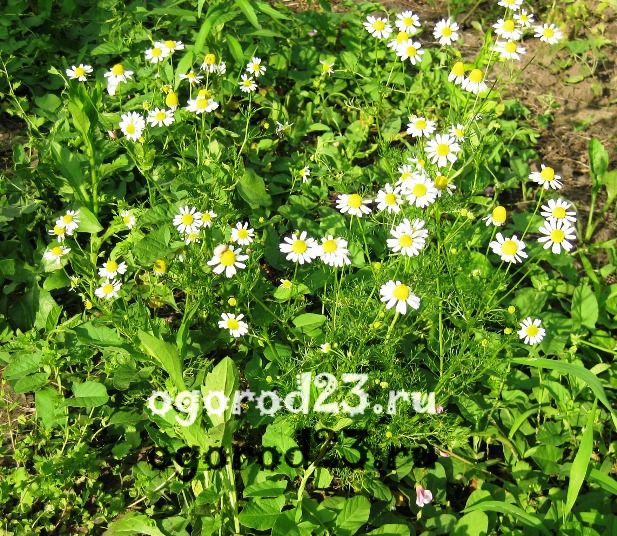 Chamomile - beautiful, useful, but only outside the garden
Chamomile - beautiful, useful, but only outside the garden I tried here to describe the main weeds whose names I know that grow in my garden. But there are some whose names I don’t know... I’ll try to gradually post photos of weeds unknown to me, and from you, dear readers of my blog, I’m waiting for messages in the comments - maybe someone knows, will write its name, distinctive features which will help you get rid of it quickly.
By the way, you can take a photo of your weed and attach the picture to the comment. Perhaps, through joint efforts, we will “recognize her by sight” - it will become more difficult for weeds to live with us.
P.S. The article was written a long time ago. I actually used Roundup for several years in a row. But now, I would not suggest it to you for weed control - information has emerged about the almost fatal effects of one of the components of Roundup - glyphosate. The world's most widely used herbicide may be causing cancer, the world's leading oncologists have said! I have not found information anywhere about the mechanism of action of Roundup on the human body. I can only assume that it is harmful to inhale small droplets when spraying. It is dangerous for the skin and mucous membranes. If you still decide to use Roundup, then be sure to use protective equipment - a respirator or bandage, goggles, gloves, trousers to protect your eyes, skin of your hands, and feet from getting the product. Roundup is actively promoted by Monsanto, but may appear here under trademarks“Rodeo”, “Accord”, other names may appear over time.

I want to tell you how I fight weeds in my area. garden paths and between flower beds.
Many years ago, when I created my flower garden, I used film between the flower beds: I laid the film and then covered everything with gravel. For several years I had no troubles: it was clean and no weeds grew. But over time, the earth filled up and weeds began to sprout on my paths and in the flower garden.
Just recently I found a way to deal with them. Weed control can be done using vinegar, as it is very effective and harmless to humans.
My advice. It should be remembered that vinegar destroys both weeds and other vegetation.
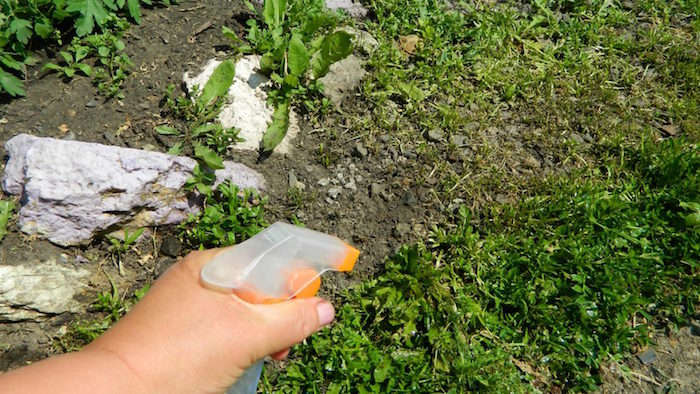
It is better to use vinegar as a herbicide on a sunny, windless day, as this will not allow the solution to get on other crops. If you need to apply the solution to selected areas, then the best solution will moisten the brush in the solution. Keep in mind that you need to be careful when handling acid, use rubber gloves and, if possible, eye protection to avoid getting burned.
Citric acid can be used together with vinegar or separately. To do this, you need to dilute it in 1 liter hot water 3 tbsp. spoons of powder citric acid, which can be purchased at grocery store. Mix everything thoroughly, cool until warm and spray the plants.
If you add salt to vinegar, a strong mixture is formed that simply does not allow the weeds to survive. It will get rid of weeds for a long time. This composition is prepared as follows: 5 tbsp. add tablespoons of vinegar to 1 liter of water and mix 2 tbsp. spoons of salt. The water must be brought to a boil, then add vinegar and add salt. I also add a little dishwashing liquid or liquid soap. Mix everything and spray the hot mixture from a spray bottle onto the weeds, and this should be done carefully so that the solution does not affect other plants.
The greatest effect will be achieved on a hot sunny day, in calm weather. Yesterday I sprayed the paths near the flower beds, and today all the weeds have withered and turned yellow. This is the way I fight weeds on the paths and between the bushes and flower beds. If anyone likes this method of dealing with unwanted vegetation, I will be glad.
Natalya Panteleeva, Chelyabinsk region,
The nightmare of any summer resident is weeds that take over living space from cultivated plants and are carriers of diseases. If they are not destroyed, then by shading the ground with leaves, they do not allow the soil to ventilate and create favorable conditions for the formation of rot and mold, which will subsequently destroy vegetable and berry crops.
There are about 2 thousand species of weeds that enter the site in different ways and have different life cycles:
- annuals;
- two-year-olds;
- perennial.
Young annual and biennial weeds can be destroyed by weeding. It is better to weed them on damp soil, after watering or rain. In this case, the plant is easily pulled out of the ground along with the roots. Weeding is carried out several times during the summer, preventing flowering and scattering of seeds.
It is more difficult to eliminate perennials that have a strong, branched root system. Manual weeding usually does not produce results, so chemicals are used to remove weeds.
Chemicals for weed control
The main means of control are herbicides. Many wide-spectrum drugs have been created on their basis.
One of the most interesting - Zenkor.
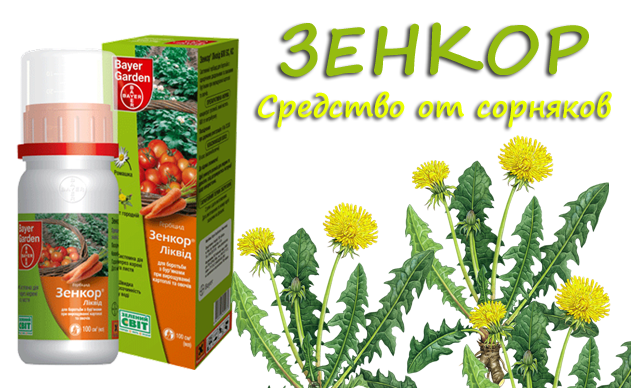
This is a selective herbicide, used in various proportions to kill weeds on tomatoes and potatoes. The drug acts only on weeds, ensuring the cleanliness of crops for 1-2 months, and it does not harm cultivated plants.
Herbicide Tornado universal,
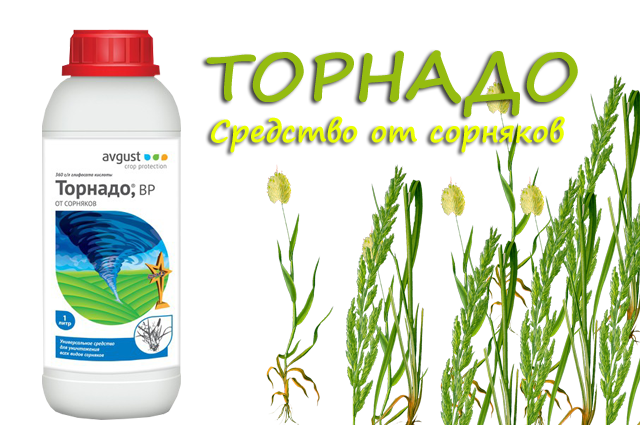
with its help you can fight the most resistant and powerful types of weeds, but you must use diluted Tornado with caution - the herbicide kills all plants indiscriminately, including berry bushes and fruit trees.
Agrokiller- a continuous action drug,
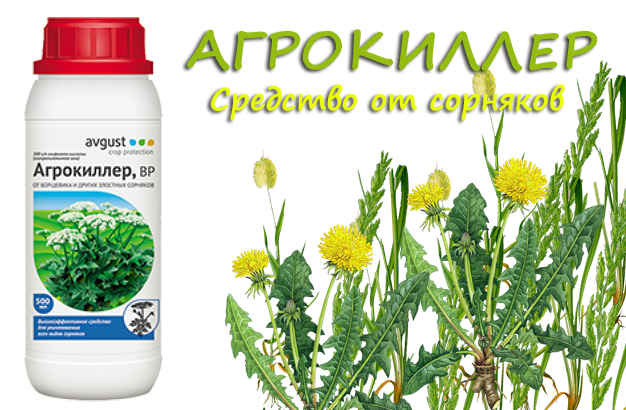
therefore, treatment should be carried out 2 weeks before planting the seedlings. This time will be enough for all the weeds to die. In the soil, Agrokiller quickly loses activity and will not affect seedlings.
Industrial herbicides help control weeds, but most gardeners prefer to do without “chemicals” on their site. The drugs are effective, but if the instructions for use are not followed, they can harm vegetables and flowers.
Note!
All herbicides are quite toxic to bees and pets!
If you do not want to use the “heavy artillery” of herbicides, gardeners will come to the rescue folk recipes, time-tested. For those who prefer home methods, weed killer vinegar is indispensable; How to dilute a vinegar solution is described in several recipes.
Folk remedies against weeds using vinegar
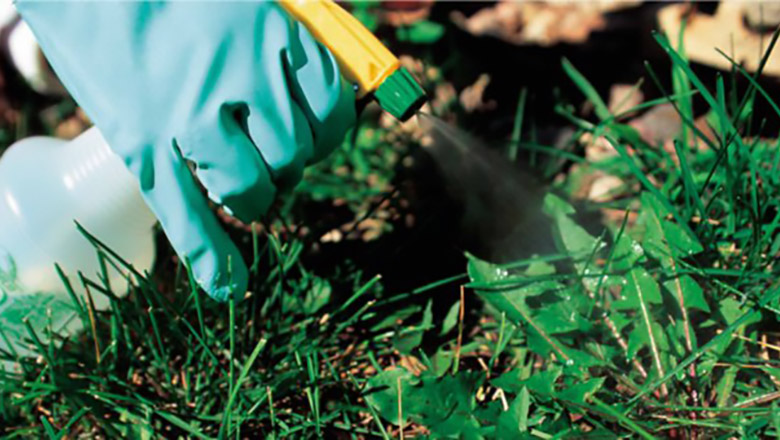
“Ecological” methods of removing weeds are based on the use of mixtures prepared on the basis of familiar household products– table vinegar, salt, laundry soap. The most effective is considered to be a mixture of vinegar and salt against weeds. To prepare it you need:
- a bucket of water;
- 2 cups 9% vinegar;
- 2 tbsp. spoons of grated laundry soap;
- 2 tbsp. spoons of coarse salt.
Dissolve all ingredients in water and spray the weeds. When spraying, be careful not to let the solution get on vegetable crops. It is better to carry out treatment early in the morning so that the water evaporates more slowly and the effect of the product increases.
To combat weeds growing in sunny areas, a vodka solution is used. Components:
- 2 glasses of water;
- 50 ml vodka;
- 2 tbsp. spoons of liquid soap.
Mix all the ingredients and spray the weeds through a spray bottle. They will dry out quickly and will not appear in this place again soon.
You can make a natural spray to get rid of particularly active weeds using vinegar. Spray ingredients:
- 2 cups 9% vinegar;
- 2 tbsp. spoons of citric acid;
- 2 tbsp. spoons detergent"Fairy";
- 50 ml vodka.
Add 3 cups of water to the mixture and spray. This “spray” is a real explosive mixture for weeds and an excellent recipe for their destruction.
Majority traditional methods weed control is based on the use of vinegar and soap components. Acetic acid effectively affects the leaves and stem, and the soap “sticks” the solution to the plant, prolonging its effect.
Helpful advice
Salt has an adverse effect on the soil, depleting it, so use saturated saline solutions only possible in places where nothing is planned to be grown.
All home methods require several “sessions” of treating weeds. Some are especially tenacious and dangerous to people and pets. All methods are used to destroy such grasses, otherwise they will invade new territories. There is a concept of “green fire”, which very accurately characterizes the instantaneous spread of weeds across an area. To prevent this from happening in your garden, you should carry out the treatment as needed, without adhering to a specific schedule.
When treating the area with compounds homemade Vinegar-based products require precautions. Industrial herbicides come with instructions for use, and folk methods no instructions.
It is enough to follow the usual safety requirements to avoid injuries while working in the garden:
- When diluting mixtures, use rubber gloves;
- avoid contact of the composition with open areas body and eyes;
- when spraying, use a spray bottle with a jet nozzle to prevent the solution from getting on crop plants;
- do not store the prepared product;
- Keep children and pets away from treated plants until the solution has completely dried.
When using compounds prepared at home, one should not forget that they do not have a selective, but a continuous effect, and have the same effect on weeds and cultivated plants. If the solution is applied inaccurately and it gets on the beds or flowers, the crops will die first because they do not have vitality plants - pests. To prevent this from happening, you can use a brush to apply the mixture to the weeds - in this case, the solution will not get on the crops.
Each gardener chooses his own ways of dealing with harmful plants. Some treat their plots with chemical herbicides, while others use “folk” vinegar. In both cases, the treatment of the area from weeds must be approached responsibly, so as not to “get rid of” the cultivated plants along with the weeds.
Video recipes
Weeds are the long-time enemies of any gardener. And even if there is no garden on the property, weeds can seriously spoil a beautifully trimmed lawn, turning it into a sloppy field overgrown with grass. There are a lot of methods and means of weed control today: from traditional folk to “advanced” high-tech ones. You can choose the tool that suits you best.
To make it easier to navigate the variety of different weed control agents and preparations, in the article we will give detailed review the most effective of them. In addition, we will find out the prices of drugs and find out what means are best to destroy weeds on the lawn and in the garden.
So, today farmers know two main ways to combat weeds:
- agrotechnical methods;
- agrochemicals.
Let's take a closer look different kinds means that relate to one and another method. First, we’ll talk about gardening, and we’ll talk about the lawn separately.
Agricultural technology
Weeding and digging
Traditional methods of weed control have been used in agriculture for a long time. These are methods that are safe from an environmental point of view, quite reliable, but require a lot of effort and effort.
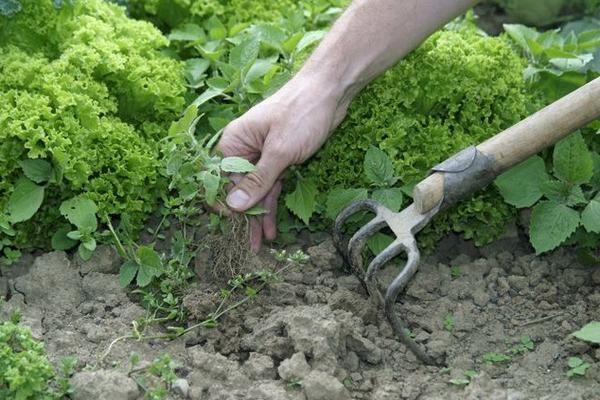
Weeding
As a rule, these manipulations cannot be avoided in any case, so weeding and digging the beds must be done periodically in any case. But what is an effective way to control weeds, and how to choose it for yourself, is indicated
Mulching
Enough effective way, does not pollute the soil harmful substances. Along with protecting against weeds, mulching helps retain moisture in the ground, which also has a beneficial effect on the development of plants.
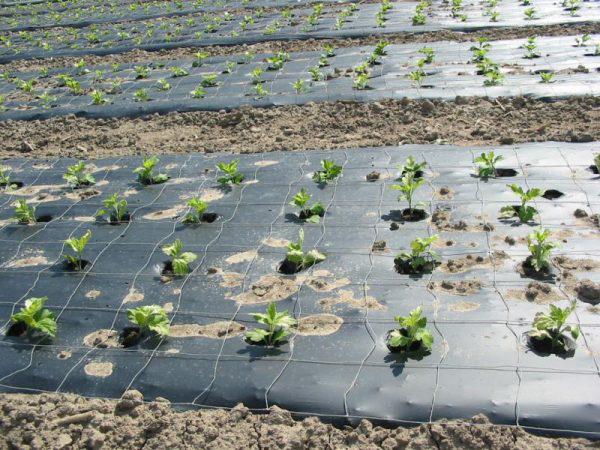
Mulching weeds
The most commonly used inorganic material for weed control is black, opaque film. This is the so-called Swedish method destruction of weeds. The material allows you to get rid of weeds safely and environmentally (simply by preventing them from sprouting).
Although such a film is not cheap, it can be used for several years: it is usually used to protect vegetable beds and strawberry.
Agrochemistry
Herbicides
This is one of the most effective methods of weed control today. Herbicides are ideal if the field is heavily overgrown or if it needs to be treated large area. These drugs are divided, in turn, into several types: continuous and selective action, systemic, contact and soil type.
Let's look at the most popular herbicides used in agriculture today.
Roundup
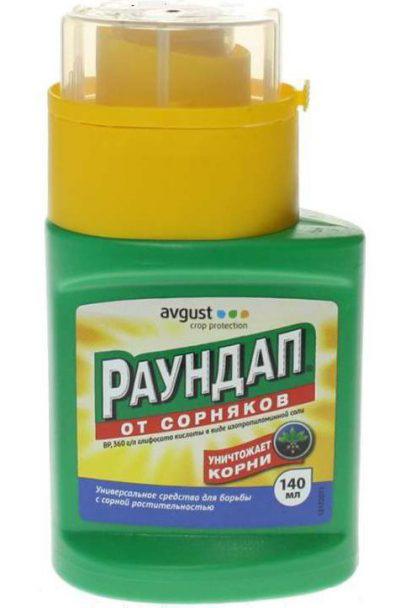
This is probably the most popular herbicide today. Its advantage is safety: Roundup does not harm the soil or livestock. Cultivated plants can be planted immediately after treating the soil with this herbicide.
Herbicide Roundup
Roundup is effective against most weeds: they are defeated within 8-10 days. Over the designated period of time, the weeds die completely, withering. The principle of action of the herbicide is aimed at suppressing the synthesis of amino acids in weeds.
Tornado
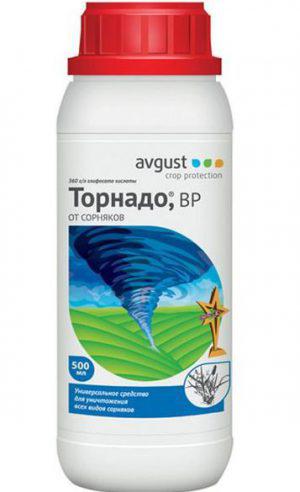
This product is most often used to destroy weeds in orchards and vineyards. Tornado is effective against both annual weeds and perennials.
This is a continuous action product, so it is important that no cultivated plants get in its way. Causes the death of weeds 7-10 days after spraying. To learn more about Tornado for weed control, you can find out This herbicide effectively controls annual and perennial weeds. He is good at learning new things land plots
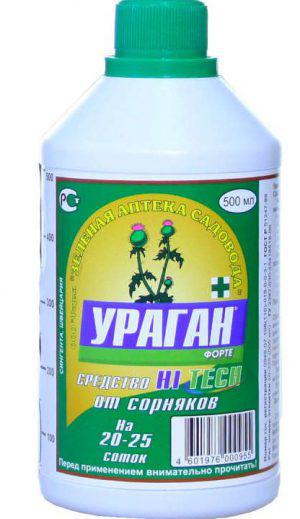
, when cultivating the soil around greenhouses. Great for killing weeds on the lawn. Completely destroys weeds 2-3 weeks after spraying. The composition acts on the plant from the inside, gradually bringing it to complete withering. Hurricane can be used throughout the growing season: from early spring
and until late autumn. You can learn more about the drug Hurricane for weeds from this
Glyphos Another to kill weeds. Glyphos is safe because it destroys weeds by affecting the synthesis of their amino acids. A positive effect is observed when destroying both perennial and annual weeds.
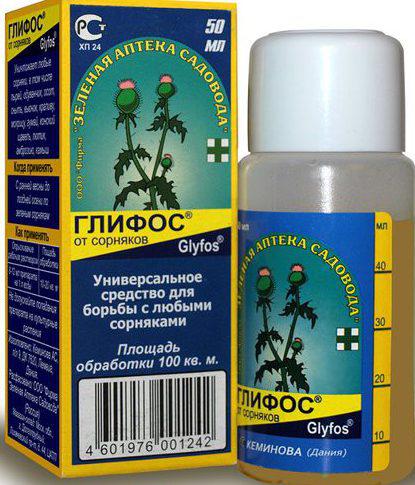
Saltpeter
High efficiency against weeds, a chemical such as ammonium nitrate. In order for the substance to cope with weeds, it is necessary to dilute 3 kg of saltpeter in a bucket of water, and then spray the weed thickets with the resulting solution. It is recommended to use the product only if the weeds have really grown greatly. This method is good because saltpeter burns the grown weeds, while itself settling in the soil, and then acting on cultivated plants as a fertilizer. But the information on the link will help you understand how to do it correctly.
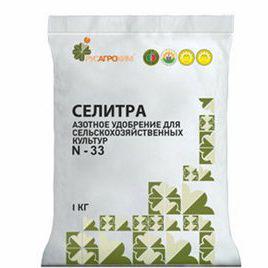
The chemical method helps when the mechanical method is powerless: in case the area is heavily overgrown with weeds, or when no other methods help. Effectively apply herbicides simultaneously with fertilization. But this method can only be used for small plots garden/garden. If during the herbicide treatment the substance gets into empty areas, then the latter can be sown only after a few weeks.
But when to plant basil in open ground in the spring, and what results can be achieved from planting, are described in great detail in this
Features of killing weeds on the lawn
If there are many techniques, methods and means for garden weed control, then in order to clear the lawn of “invaders”, some of the listed methods will not be suitable. After all, in the green grass that grows on the lawn, weeds will certainly be found, which must be destroyed without consequences for the “cultivated” grass.
The fight against weeds growing on the lawn, unlike those growing in the garden, does not stop all summer. If the beds can be sprayed and then not see weeds on them for a month or two, then the lawn will have to be cleaned regularly: only this approach will help make this area of the garden beautiful and tidy.
The video shows the features of removing weeds on the lawn:
It is recommended that before planting grass for the lawn, you first carry out preventive work to destroy the weeds present in the area. To do this, you can use traditional digging or spray herbicide.
It is also important to mow the lawn regularly so that weeds do not have time to spoil its neat, “combed” appearance. Regular mowing will allow you to cope with such particularly persistent weeds as woodlice, dandelion, wheatgrass, nettle, bindweed and others. After each cutting, the strength of the weed weakens, and over time there is less and less of the latter.
In addition, it is necessary to provide the lawn with sufficient fertilizing with appropriate fertilizers, which, along with nutrition, can protect it from fungal diseases and various viruses. If the lawn is attacked by moss, aerating the soil will help. Simply put: you need to let air under the turf by piercing the lawn with a fork in several places.
If herbicides are used to eliminate weeds in your lawn, choose the product very carefully. Keep in mind that turf contains several types of grass that can be affected by herbicides; these grasses may disappear completely after treatment.
If you are processing lawn grass means of complete destruction, then the next haircut can be done only four days after the procedure. In general, it is allowed to treat a lawn with herbicides no earlier than a year after its arrangement.
To protect a green lawn from invasion of weeds, so-called lawn sand is often used. This substance is also a fertilizer, as it contains ammonium sulfate and ferrous sulfate. The product is scattered over the surface of the lawn, after which moss and pest plants gradually disappear from the lawn. Iron sulfate in this case acts as a poison for weeds, and ammonium sulfate feeds cultivated plant specimens. It is most effective to use lawn sand at the beginning of the season: May-June.
After cutting grass treated with lawn sand, it cannot be used to mulch garden crops.
Review of drugs
Let's find out at what price we can buy weed killers now.
Lapis lazuli
We can purchase this popular herbicide for potato and tomato fields from the August company at a price of 2,000 rubles per 5-liter canister.
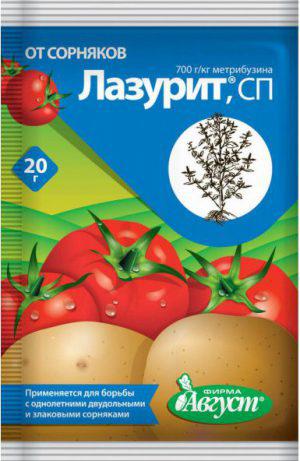
Lapis lazuli for weeds
Roundup is effective against most weeds: they are defeated within 8-10 days. Over the designated period of time, the weeds die completely, withering. The principle of action of the herbicide is aimed at suppressing the synthesis of amino acids in weeds.
This effective product with excellent penetrating ability from the same company can be purchased at a price of 100 rubles per half-liter container.
Let's look at the most popular herbicides used in agriculture today.
A popular and reliable herbicide is sold at a price of 370 rubles per container of 0.14 kg. The consumption of the product is extremely economical, so such a small volume will be enough for a decent-sized field.
and until late autumn. You can learn more about the drug Hurricane for weeds from this
It's effective and safe remedy can be purchased at a price of about 700 rubles per half-liter package. The consumption of the drug is extremely economical, so one package is usually enough for a standard country cottage area, the remedy still remains.
The video shows the use of herbicides:




